市场营销实训第4章参考答案
国家开放大学《市场营销学》即时练习1-12章参考答案
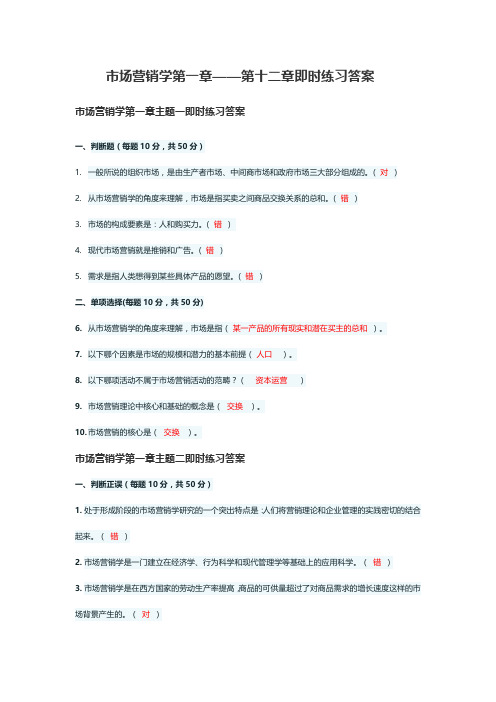
市场营销学第一章——第十二章即时练习答案市场营销学第一章主题一即时练习答案一、判断题(每题10分,共50分)1.一般所说的组织市场,是由生产者市场、中间商市场和政府市场三大部分组成的。
( 对)2.从市场营销学的角度来理解,市场是指买卖之间商品交换关系的总和。
( 错)3.市场的构成要素是:人和购买力。
( 错)4.现代市场营销就是推销和广告。
( 错)5.需求是指人类想得到某些具体产品的愿望。
( 错)二、单项选择(每题10分,共50分)6.从市场营销学的角度来理解,市场是指(某一产品的所有现实和潜在买主的总和)。
7.以下哪个因素是市场的规模和潜力的基本前提(人口)。
8.以下哪项活动不属于市场营销活动的范畴?(资本运营)9.市场营销理论中核心和基础的概念是(交换)。
10.市场营销的核心是(交换)。
市场营销学第一章主题二即时练习答案一、判断正误(每题10分,共50分)1.处于形成阶段的市场营销学研究的一个突出特点是:人们将营销理论和企业管理的实践密切的结合起来。
(错)2.市场营销学是一门建立在经济学、行为科学和现代管理学等基础上的应用科学。
(错)3.市场营销学是在西方国家的劳动生产率提高,商品的可供量超过了对商品需求的增长速度这样的市场背景产生的。
(对)4.市场营销学是本世纪初在英国产生的。
( 错)5.市场营销学的研究对象应当是“以消费者需求为中心的市场营销关系、市场营销规律及市场营销策略”。
(对)二、单项选择(每题10分,共50分)6.人们在研究市场营销学发展史时,常以( 1912年赫杰特齐教授编写的《市场营销学》的出版)作为学科诞生的标志。
7.以下什么事件标志着市场营销学已经跨出了大学讲坛,引起了整个社会的兴趣和关注,成为一门实用的经济科学。
( “全美市场营销协会”(AMA)成立)8.在市场营销的初创阶段,其主要研究内容是(推销与广告的方法)。
9.市场营销学作为一门独立学科出现是在(20世纪初)。
10.市场营销学是一门(应用科学)。
市场营销复习与思考题参考答案

《市场营销--理论、工具、实务》复习与思考参考答案第1章营销概述1.谈谈你对市场营销的理解和认识?【答】有些人片面的理解,把市场营销等同于推销。
然而推销并非是营销,推销仅仅是市场营销的内容之一。
著名管理学家彼得·德鲁克曾经指出,“可以设想,某些推销工作总是需要的,然而营销的目的就是要使推销成为多余,营销的目的在于深刻地认识和了解顾客,从而使产品或服务完全地适合它的需要而形成产品自我销售,理想的营销会产生一个己经准备来购买的顾客,剩下的事就是如何便于顾客得到产品或服务……”美国营销学权威菲利普·考恃勒认为,“营销最重要的内容并非是推销,推销只不过是营销冰山上的顶点……。
正如著名学者所述,营销不是推销。
营销工作早在产品制成之前就开始了。
企业营销部门首先要确定那里有市场,市场规模如何,有哪些细分市场,消费者的偏好和购买习惯如何: 营销部门必须把市场需求情况反馈给研究开发部门,让研究开发部门设计出适应该目标市场的最好的可能产品。
营销部门还必须为产品走向市场而设计定价,分销和促销计划,让消费者了解企业的产品,方便地头到产品。
在产品售出后,还要考虑提供必要的服务,让消费者满意。
所以说,营销不是企业经营活动的某一方面,它始于产品生产之前,并一直延续到产品售出以后,贯穿于企业经营活动的全过程。
尽管有关市场营销的定义不尽相同,但从这些定义中可以归纳出以下几点:(1)市场营销是一个综合的经营管理过程,贯穿于企业经营活动全过程。
(2) 市场营销是以满足顾客需要为中心来组织企业经营活动,通过满足需要而达到企业获利和发展的目标。
(3) 市场营销以整体性的经营手段,来适应和影响需求。
综上所述,我们可以对市场营销作出这样的概括,市场营销是企业以顾客需要为出发点,有计划地组织各项经营活动,为顾客提供满意的商品和服务而实现企业目标的过程。
2.传统营销理念与现代营销理念的根本区别是什么?【答】:两者的根本区别是核心利益点以及出发点的不同?传统营销理念是以企业为中心,企业擅长生产什么就生产什么,销售什么,一切以企业的经济利益为核心。
市场营销第二版习题及答案模块四 教材习题答案

(一)单项选择题.某种产品在销售期间,广告费用和其他营销费用开支最大,而企业利润很低,甚至出现亏损,该产品最有可能处于()oA .投入期B .成长期C .成熟期D .衰退期正确答案:A1.服装、首饰等属于消费者可反复购买的商品,该类商品是()。
A .便利品B .选购品C .耐用消费品D .快销品正确答案:B2.以下产品可采用无品牌策略的是()A.方便面B.农民自产蔬菜C.瓶装酱油D.瓶装牛奶正确答案:B.吉利汽车收购了沃尔沃,对吉利汽车公司来说,该产品组合策略是()。
A .产品线向上延伸B .产品线向下延伸C .产品线双向延伸D .产品线缩减正确答案:A.三叉星圆环是奔驰汽车的()。
A、品牌图案B、品牌名称C、品牌象征D、品牌标志正确答案:D3.以下营业推广方式中,不适合推销人员的是()。
A .销售竞赛B .超额提成C .年终分红D .现场示范正确答案:D4.某品牌洗发水在全国省会城市销售时,同时选择很多家超市进行销售,这种渠道属于()oA.长渠道B.宽渠道C.短渠道D.窄渠道正确答案::B5.当消费者人数众多且分布比拟分散时,适合采用()oA.直接渠道B.短渠道C.窄渠道D,宽渠道正确答案:D6.四川诚立公司预计2020年的销售额为1000万元,现以销售额的12%作为的促销费用,预算促销费用为120万元。
企业使促销费用与销售额之间保持一定比例的促销预算方法是()。
A.量力支出法B.销售比例法C.竞争对等法D.目标任务法正确答案:B7.童年玩具公司的电动玩具狗年摊固定本钱为200000元,每件电动玩具狗的单位变动本钱为30元,如果年销售量可望到达5000件,电动玩具狗保本价格是()oA . 30元B . 40元 C . 70元D . 80元正确答案:C(二)多项选择题.产品生命周期的投入期可采用的营销策略有()A.高价高促销B.低价高促销C.高价低促销D.低价低促销正确答案:A, B,C, D1.心理定价策略包括()oA .整数定价B .尾数定价C .声望定价D .撇脂定价正确答案:A, B,C.以下分销渠道中,不拥有商品所有权的有()。
《旅游市场营销》课后习题带答案第四章xt

第四章旅游市场细分与目标市场选择一、思考题1.简述旅游市场细分的作用。
(1)有利于旅游企业识别和发掘旅游市场,开发旅游新产品,开拓旅游新市场。
(2)有利于旅游企业针对性地制定和调整旅游市场营销组合策略。
(3)有利于旅游企业优化资源配置和取得良好的经济效益。
2.进行旅游市场细分时应遵循的原则有哪些?(1)可衡量性(2)可实现性(3)可盈利性(4)可区分性(5)稳定性3.旅游市场细分常用的变量有哪些?(1)地理变量(2)人口变量(3)心理变量(4)行为变量4.如何评价细分市场?(1)各个细分市场的规模和增长率(2)细分市场的结构吸引力(3)旅游企业目标和资源5.选择目标市场时可选择的市场营销战略有哪些?各自的优缺点是什么?分别适用于哪些情形?(1)市场集中化。
优点:旅游企业可以更加了解该细分市场的需要,树立良好的形象,建立相对稳固的市场地位,获得良好的经济效益;缺点:经营风险比较大,一般适合实力相对较弱的中小旅游企业。
该模式适用于实力小的企业,只选取一个细分市场作为目标市场,提供一种产品供应单一的顾客群,进行集中营销。
(2)产品专业化。
优点:旅游企业能够专注于某一种或某一类旅游产品,有利于形成和发展产品优势,在该领域树立形象;缺点是当该领域被一种全新产品所替代时,产品销售量会有大幅度下降的危险。
适用于实力较小的企业,只提供某一种产品,并向若干个细分市场的顾客群体销售。
(3)市场专业化。
优点:旅游企业经营的产品类型众多,能有效分散经营风险;缺点:由于集中于某一类顾客,当这类顾客的需求下降时,企业也会遇到收益下降的风险。
适用于实力较小的企业,专门经营满足某一类顾客群体需要的各种产品。
(4)选择专业化。
优点:可以有效地分散经营风险,即使某个细分市场盈利情况不佳,仍可在其他细分市场取得盈利;缺点:采用这种模式对企业的资源和实力要求较高。
适用于实力较强的企业,选取若干个具有良好的盈利潜力和结构吸引力,且符合企业目标和资源的细分市场作为目标市场。
市场营销复习资料带答案---第4章 复习题
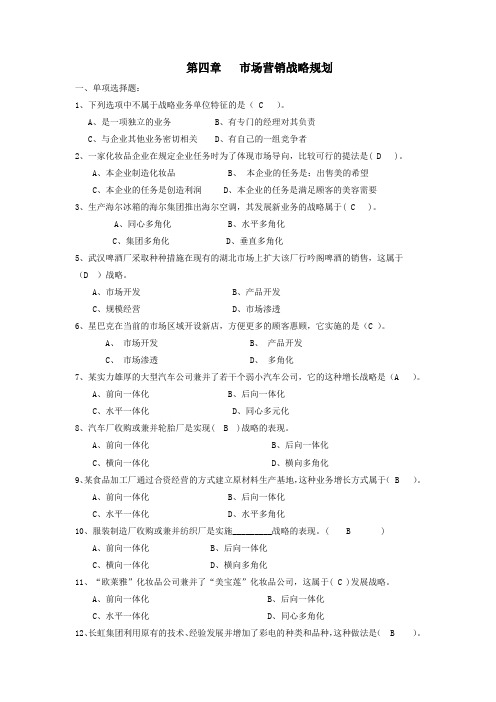
第四章市场营销战略规划一、单项选择题:1、下列选项中不属于战略业务单位特征的是( C )。
A、是一项独立的业务B、有专门的经理对其负责C、与企业其他业务密切相关D、有自己的一组竞争者2、一家化妆品企业在规定企业任务时为了体现市场导向,比较可行的提法是( D )。
A、本企业制造化妆品B、本企业的任务是:出售美的希望C、本企业的任务是创造利润D、本企业的任务是满足顾客的美容需要3、生产海尔冰箱的海尔集团推出海尔空调,其发展新业务的战略属于( C )。
A、同心多角化B、水平多角化C、集团多角化D、垂直多角化5、武汉啤酒厂采取种种措施在现有的湖北市场上扩大该厂行吟阁啤酒的销售,这属于(D )战略。
A、市场开发B、产品开发C、规模经营D、市场渗透6、星巴克在当前的市场区域开设新店,方便更多的顾客惠顾,它实施的是(C )。
A、市场开发B、产品开发C、市场渗透D、多角化7、某实力雄厚的大型汽车公司兼并了若干个弱小汽车公司,它的这种增长战略是(A )。
A、前向一体化B、后向一体化C、水平一体化D、同心多元化8、汽车厂收购或兼并轮胎厂是实现( B )战略的表现。
A、前向一体化B、后向一体化C、横向一体化D、横向多角化9、某食品加工厂通过合资经营的方式建立原材料生产基地,这种业务增长方式属于( B )。
A、前向一体化B、后向一体化C、水平一体化D、水平多角化10、服装制造厂收购或兼并纺织厂是实施_________战略的表现。
( B )A、前向一体化B、后向一体化C、横向一体化D、横向多角化11、“欧莱雅”化妆品公司兼并了“美宝莲”化妆品公司,这属于( C )发展战略。
A、前向一体化B、后向一体化C、水平一体化D、同心多角化12、长虹集团利用原有的技术、经验发展并增加了彩电的种类和品种,这种做法是( B )。
A、水平多角化B、同心多角化C、集团多角化D、产品开发13、生产容声牌冰箱的广东科龙公司1993年投资建成了空调器厂,这种发展新业务的方式属于( B )。
科特勒市场营销第四章习题答案

科特勒市场营销第四章习题答案LTChapter 4 Managing Marketing Information to Gain Customer Insights1) Despite the data glut that marketing managers receive, they frequently complain that they lack ________.A) enough information of the right kindB) timely informationC) accurate informationD) reliable informationE) valid informationAnswer: ADiff: 2 Page Ref: 100AACSB: CommunicationSkill: ConceptObjective: 4-12) A marketing information system (MIS) consists of people and procedures to assess information needs, ________, and help decision makers analyze and use the information.A) experiment to develop informationB) test market the informationC) develop the needed informationD) critique the needed informationE) question the needed informationAnswer: CDiff: 1 Page Ref: 101AACSB: CommunicationSkill: ConceptObjective: 4-13) A good MIS balances the information users would ________ against what they really________ and what is ________.A) need; like; feasibleB) like; can afford; neededC) like to have; need; feasible to offerD) need; can afford; usefulE) use; have to use; availableAnswer: CDiff: 3 Page Ref: 102Skill: ConceptObjective: 4-24) Marketers must weigh carefully the costs of additional information against the ________ resulting from it.A) organizationB) benefitsC) creativityD) ethical issues133Copyright © 2010 Pearson Education, Inc. Publishing as Prentice HallE) costAnswer: BDiff: 1 Page Ref: 102Skill: ConceptObjective: 4-25) Four common sources of internal data include the accounting department, operations, the sales force, and the ________.A) ownersB) stockholdersC) marketing departmentD) competitionE) WebAnswer: CDiff: 2 Page Ref: 103AACSB: CommunicationSkill: ConceptObjective: 4-26) ________ is the systematic collection and analysis of publicly available information about consumers, competitors, and developments in the marketing environment.A) Marketing dataB) Marketing intelligenceC) Sales managementD) Customer intelligenceE) Competitive intelligenceAnswer: BDiff: 1 Page Ref: 103Skill: ConceptObjective: 4-27) Which of the following is NOT considered a source of marketing intelligence?A) suppliersB) resellersC) key customersD) causal researchE) activities of competitorsAnswer: DDiff: 2 Page Ref: 104Skill: ConceptObjective: 4-28) Which of the following is NOT a potential source for marketing intelligence?A) looking through competitors' garbageB) purchasing competitors' productsC) monitoring competitors' sales134Copyright © 2010 Pearson Education, Inc. Publishing as Prentice Hall133Copyright © 2010 Pearson Education, Inc. Publishing as Prentice Hall133Copyright © 2010 Pearson Education, Inc. Publishing as Prentice HallD) always necessary to support primary dataE) not always very usableAnswer: EDiff: 2 Page Ref: 109Skill: ConceptObjective: 4-317) For primary data to be useful to marketers, it must be relevant, current, unbiased, and ________.A) completeB) accurateC) inexpensiveD) collected before secondary dataE) experimentalAnswer: BDiff: 2 Page Ref: 109Skill: ConceptObjective: 4-318) Focus group interviewing has become one of the major marketing research tools for getting insight into consumer thoughts and feelings. However, if the sample size is too small, it is likely to be difficult to ________.A) find enough secondary data to support the findingsB) orchestrate cooperation among participantsC) encourage honest responses to questionsD) generalize from the resultsE) find a representative sampleAnswer: DDiff: 2 Page Ref: 112Skill: ConceptObjective: 4-319) Marketing researchers usually draw conclusions about large groups of consumers by studying a small ________ of the total consumer population.A) groupB) target groupC) populationD) sampleE) audienceAnswer: DDiff: 1 Page Ref: 115Skill: ConceptObjective: 4-320) The most common research instrument used is the ________.A) mechanical device133Copyright © 2010 Pearson Education, Inc. Publishing as Prentice HallB) live interviewerC) questionnaireD) focus groupE) people meterAnswer: CDiff: 2 Page Ref: 118Skill: ConceptObjective: 4-321) In marketing research, the ________ phase is generally the most expensive and most subject to error.A) exploratory researchB) planningC) interpreting the findingsD) reporting the findingsE) data collectionAnswer: EDiff: 2 Page Ref: 119Skill: ConceptObjective: 4-322) AMF Research Group must guard against problems during the implementation phase of marketing research for its clients. Which of the following is NOT a problem that should be anticipated during this phase?A) contacting respondentsB) respondents who give biased answersC) interviewers who take shortcutsD) interpreting and reporting the findingsE) interviewers who make mistakesAnswer: DDiff: 2 Page Ref: 119Skill: ConceptObjective: 4-323) Typically, customer information is buried deep in separate databases, plans, and records of many different company functions and departments. To overcome such problems, which of the following should you try?A) customer satisfaction managementB) more sophisticated hardwareC) customer relationship managementD) decreased marketing intelligenceE) a marketing information systemAnswer: CDiff: 1 Page Ref: 120Skill: ConceptObjective: 4-4134Copyright © 2010 Pearson Education, Inc. Publishing as Prentice Hall24) Which of the following is true about customer relationship management (CRM)?A) It relies on information produced through primary research.B) Its aim is to maximize profit margins.C) Its aim is to increase the efficiency of each customer touchpoint.D) Its aim is to maximize customer loyalty.E) Most companies who first implemented CRM have greatly benefited from the results. Answer: DDiff: 2 Page Ref: 120AACSB: CommunicationSkill: ConceptObjective: 4-425) What source of marketing information provides those within the company ready access to research information, stored reports, shared work documents, contact information for employees and other stakeholders, and more?A) an intranetB) an extranetC) the InternetD) marketing researchE) marketing intelligenceAnswer: ADiff: 2 Page Ref: 122AACSB: Use of ITSkill: ConceptObjective: 4-326) Marketing information is only valuable when it is used to ________.A) simplify management's jobB) identify a target marketC) please shareholdersD) increase efficiencies in the supply chainE) make better marketing decisionsAnswer: EDiff: 2 Page Ref: 122Skill: ConceptObjective: 4-427) Small organizations can obtain, with minimal effort, most of which type of data available to large businesses?A) observationalB) experimentalC) touch pointD) primaryE) secondaryAnswer: EDiff: 2 Page Ref: 123135Copyright © 2010 Pearson Education, Inc. Publishing as Prentice HallSkill: ConceptObjective: 4-528) The availability of which of the following is most problematic in international marketing research?A) primary dataB) research specialistsC) secondary dataD) intelligence limitationsE) consumers willing to answer survey questionsAnswer: CDiff: 2 Page Ref: 124AACSB: Multicultural and DiversitySkill: ConceptObjective: 4-529) An effective MIS assesses information needs, develops needed information, and helps decision makers use the information.Answer: TRUEDiff: 1 Page Ref: 101AACSB: CommunicationSkill: ConceptObjective: 4-130) Too much marketing information can be as harmful as too little.Answer: TRUEDiff: 2 Page Ref: 102Skill: ConceptObjective: 4-231) Your manager asked you to go through three of your competitors' garbage bins to gather marketing intelligence from their discarded paperwork. One of them caught you in the act and has summoned you to court. The judge will most likely rule this to be an illegal activity and fine you and your company.Answer: FALSEDiff: 3 Page Ref: 104AACSB: Ethical ReasoningSkill: ApplicationObjective: 4-232) Because secondary data provide good starting points and often help to define problems and research objectives, most companies do not also need to collect primary data. Answer: FALSEDiff: 2 Page Ref: 109Skill: ConceptObjective: 4-3136Copyright © 2010 Pearson Education, Inc. Publishing as Prentice Hall33) Ideally, a sample should be representative so that the researcher can make accurate estimates of the thoughts and behaviors of the larger population.Answer: TRUEDiff: 1 Page Ref: 116Skill: ConceptObjective: 4-334) A researcher who wants to calculate confidence limits for sampling error would use nonprobability samples.Answer: FALSEDiff: 3 Page Ref: 116Skill: ConceptObjective: 4-335) Open-ended survey questions are particularly useful in exploratory research. Answer: TRUEDiff: 2 Page Ref: 118AACSB: CommunicationSkill: ConceptObjective: 4-336) Interpretation of market research data should be the responsibility of the researchers, not the marketing managers.Answer: FALSEDiff: 2 Page Ref: 120Skill: ConceptObjective: 4-337) Discuss the makeup and functions of a marketing information system (MIS). Answer: A typical MIS consists of people, equipment, and procedures to gather, sort, analyze, evaluate, and distribute needed, timely, and accurate information to marketing decision makers. First, it interacts with information users to assess information needs. Next, it develops needed information from internal company databases, marketing intelligence activities, and marketing research. Finally, it helps users to analyze and use the information to develop customer insights, make marketing decisions, and manage customer relationships.Diff: 2 Page Ref: 101-102AACSB: CommunicationSkill: ApplicationObjective: 4-1137Copyright © 2010 Pearson Education, Inc. Publishing as Prentice Hall。
市场营销学第四章课后练习

17.市场营销策划的最后一部分是营销控制。营销控制是用来对策划的执行过程、进度和意 外情况进行管理、监督和应对的,核心内容是监督策划的销售和利润目标能否顺利完成。 答案为 D 18.发展是指通过投资来扶持和发展有潜力的业务单位。这种战略的目的是扩大战略些业务的市场地位。这种战略的目的是维持战略业务单位的相对 市场份额。 答案为 B 20.收获战略一般是指在计划中逐渐减少成本,并最终放弃某项业务。其战略目的是短期内 快速增加战略业务单位的现金,而不考虑其长期效益。 答案为 C 21.放弃是指公司逐渐减少对某些业务的投资,适时退出市场。这种战略的目的是出售或清 算业务,摆脱无法盈利的业务单位,以便把资源转移到更加有利的领域。 答案为 D 22.同心多角化战略的关键在于以现有生产技术和营销资源为核心。由于公司是从同一圆心 向外扩展业务,没有脱离原来的经营主线,因而有利于充分发挥现有的资源优势,风险相对 较小。 答案为 A
一、单项选择题 1 企业的市场营销活动是为实现自身价值目标服务的,首先必须以满足消费者需求为中心。 答案为 A 2.企业的市场营销活动是为实现自身价值目标服务的,首先必须以满足消费者需求为中心。 答案为 D 3.企业的营销策划始于具体目标的确立,又必须立足于现状。因此,其最终成效取决于 2 个 方面:一方面,营销策划是围绕企业目标展开的,目标确立合理与否直接决定营销策划的效 果;另一方面,营销策划又必须从企业现状出发,策划成功与否的关键在于对企业现状的认 识是否充分。 答案为 B 4.营销策划是企业在具体的营销过程中明确自身行动是否偏离预定轨道的重要标准。 答案为 A 5.在激烈的市场竞争中,企业要吸引和维系顾客,其营销活动必然要强调创新,而活动是以 营销策划为依据的,这就决定了营销策划必须要有创造性。 答案为 C 6.效益性是指企业的营销策划应该实现以最小的投入取得最佳的效果。 答案为 B 7.营销活动的最终目标是实现企业价值,取得经济效益,而营销策划本身也需要投入相应的 成本,因此在进行营铺策划时,应该在不影响方案质量的前提下尽可能投入最少的成本。 答案为 B 8.公司策划是企业营销策划的最高层次,其他层次的营销策划都要围绕公司策划展开。 答案为 A 9.公司策划的首要内容就是确立公司使命。公司使命指出了公司存在的原因或目的,说明公 司将要从事什么事业或满足用户的哪些需求。 答案为 D 10.在对各个业务单位的运营情况做出详细分析之后,常需要为其制定下一步走向,这其中 涉及业务拓展、紧缩或放弃。业务更新是企业保持竞争活力的一种有效手段。 答案为 D 11.产品策划是针对具体的各类产品而制定的相应策划,其实质是为各类特定产品达到预期 的市场目标而进行的策略安排。 答案为 B 12.战略策划要以可操作的战术策划为实现手段,战术策划要以战略策划为原则,为实现战 略策划的目标而服务。 答案为 A 13.营销环境与现状分析是企业营销活动的必要前提,营销目标则为企业营销活动指明了具 体方向,而行动方案则为企业营销活动规划出详尽的步骤。 答案为 C 14.营销环境与现状、营销目标和行动方案是营销策划书的主要构成内容。 答案为 B 15.在外部环境分析中,营销人员必须综合分析影响公司获利能力的关键宏观环境因素和微 观环境因素,目的是识别公司和产品在环境中面临的营销机会和威胁。 答案为 A 16.营销战略是目标实现的指导思想,是从整体的角度对企业营销活动进行纲领性的规定。 答案为 B
市场营销课后习题答案 第4章

第四章目标市场营销一、判断题1. 任何一个规模巨大、资金实力雄厚的企业也不能满足市场上全部顾客的所有需求,所以企业要进行市场细分。
(√)2. 一个规模巨大、资金实力雄厚的企业能够满足顾客的所有需求。
(×)3. 市场细分的目的就是企业根据自身的优势条件选择力所能及的,适合自己经营的目标市场。
(√)4. 市场细分就是指按照消费者的欲望与需求把一个总体市场划分成若干个具有共同特征的子市场的过程。
(√)5. 细分市场也称为子市场。
(√)6. 有效性是指细分出来的市场应是企业通过营销活动能够进入并对顾客施加影响的市场。
(√)7. 可进入性是指细分出来的子市场容量或要大到足以使企业获利。
(√)8. 市场细分的方法中的单一变量因素法就是根据消费者需求的某一个重要因素进行市场细分。
(√)9. 市场细分的方法中的多个因素组合法就是根据影响消费者需求的两种或两种以上的因素进行市场细分。
(√)10. 市场细分的方法中的系列变量因素法就是根据企业经营的特点并按照影响消费者需求的诸因素由粗到细地进行市场细分。
(√)11. 企业集中生产一种产品并向各类顾客销售这种产品叫产品专一化战略。
(√)12. 企业把整体市场看作一个大的目标市场,不进行市场细分,用一种产品、统一的市场营销组合对待整体市场,这种营销战略叫无差异营销战略。
(√)13. 把整体市场划分为若干需求与愿望在大致相同的细分市场,然后根据企业的资源和营销实力选择部分细分市场作为目标市场,并为各目标市场制定不同的市场营销组合策略,这种营销战略叫差异化营销战略。
(√)14. 把整体市场划分为若干需求与愿望在大致相同的细分市场后,只选择其中的某一部分市场作为目标市场,这种这种营销战略叫密集型营销战略。
(√)二、单项选择题1. 经过市场细分后,选择其中的多个子市场为目标市场,并针对不同子市场设计不同的市场营销组合方案,这种市场营销策略是:(C)。
A 无差异营销策略B 集中性营销策略C 差异性营销策略D 专业化营销策略2. 为避免与强大的竞争对手发生正面交锋,将自己的产品定位于远离竞争对手的区域。
市场营销学职业技能实训作业参考答案

第1题: 销售人员在不同的环境下,可根据不同潜在顾客的需求和购买动机,及时调整自己的销售策略,解答顾客的疑问,满足顾客的需要,这体现了人员销售( 灵活性)的特点。
第2题: 销售人员可以选择那些具有较大购买可能的顾客进行拜访,并可事先对潜在顾客作一番研究,拟定具体的销售方案,因而销售的成功率较高,无效劳动较少,这体现了人员销售( 选择性)的特点。
第3题: 销售人员从寻找顾客开始,到接触、磋商,最后达成交易,独立承担了整个销售阶段的任务,这体现了人员销售( 完整性)的特点。
第4题: 有经验的销售人员可以使买卖双方超越纯粹的商品货币关系,建立起一种友谊协作关系,这种亲密的长期合作关系有助于销售工作的开展,这体现了人员销售( 长远性)的特点。
第5题: 一个销售人员每次亲自与一个现实顾客或潜在顾客谈话,进行一对一的销售活动,这是销售人员与顾客进行接触的( 单个销售人员对单个顾客)方式。
第6题: 一个销售人员面对一个采购小组,向他们推荐一种或几种产品,这是销售人员与顾客进行接触的( 单个销售人员对一组顾客)方式。
第7题: 销售小组通常由企业有关部门的主管人员、销售人员、技术人员等组成,他们面对一个采购委员会推荐产品,这是销售人员与顾客进行接触的( 销售小组对一组顾客)方式。
第8题: 销售人员会同本企业有关职能部门的人员,以业务洽谈会的形式向买主销售产品,这是销售人员与顾客进行接触的( 销售会议)方式。
第9题: 以批发商为核心的自愿连锁销售网络属于( 契约式)分销系统。
第10题: 以零售商为中心自愿合作组成的销售网络属于( 契约式)分销系统。
第11题: 下列关于细分市场选择的说法中,不正确的是( 最大和增长最快的细分市场便最具有吸引力)。
第12题: 企业在评估各种不同的细分市场的时候,必须考虑( 以上都是)。
第13题: 最简单的一种目标市场选择的模式是( 密集单一市场)。
第14题: 宝洁公司在洗发水市场上的产品就有海飞丝、飘柔、沙宣等,这种目标市场选择模式是( 产品专业化)。
市场营销实训第4章参考答案
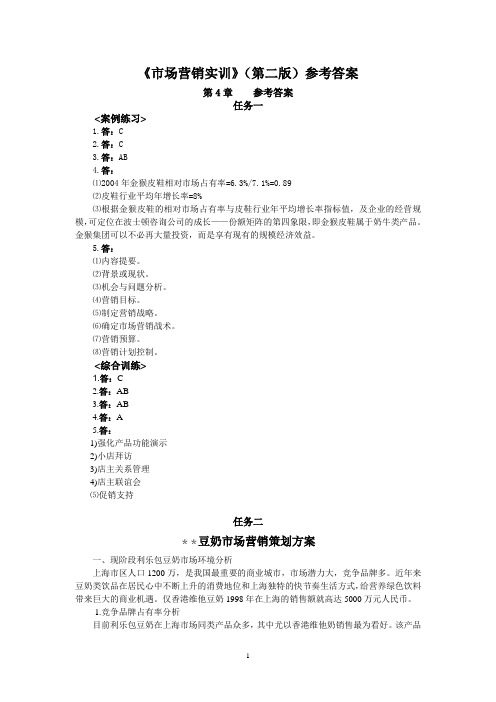
《市场营销实训》(第二版)参考答案第4章参考答案任务一<案例练习>1.答:C2.答:C3.答:AB4.答:⑴2004年金猴皮鞋相对市场占有率=6.3%/7.1%=0.89⑵皮鞋行业平均年增长率=8%⑶根据金猴皮鞋的相对市场占有率与皮鞋行业年平均增长率指标值,及企业的经营规模,可定位在波士顿咨询公司的成长——份额矩阵的第四象限,即金猴皮鞋属于奶牛类产品。
金猴集团可以不必再大量投资,而是享有现有的规模经济效益。
5.答:⑴内容提要。
⑵背景或现状。
⑶机会与问题分析。
⑷营销目标。
⑸制定营销战略。
⑹确定市场营销战术。
⑺营销预算。
⑻营销计划控制。
<综合训练>1.答:C2.答:AB3.答:AB4.答:A5.答:1)强化产品功能演示2)小店拜访3)店主关系管理4)店主联谊会⑸促销支持任务二**豆奶市场营销策划方案一、现阶段利乐包豆奶市场环境分析上海市区人口1200万,是我国最重要的商业城市,市场潜力大,竞争品牌多。
近年来豆奶类饮品在居民心中不断上升的消费地位和上海独特的快节奏生活方式,给营养绿色饮料带来巨大的商业机遇。
仅香港维他豆奶1998年在上海的销售额就高达5000万元人民币。
1.竞争品牌占有率分析目前利乐包豆奶在上海市场同类产品众多,其中尤以香港维他奶销售最为看好。
该产品占有豆奶利乐包市场实际销售额的60%以上,月均销售在400万元以上。
该产品是成熟期的品牌产品,在上海营销广告方式设计专业,营销渠道成熟,市场占有率极高,售点形象设计良好,是上海豆奶利乐包的主导品牌。
在上海豆奶利乐包产品中,销售仅次于维他奶的正广和,以都市为主导营销品牌,也吸引了部分潮流青年,销售情况日趋上升。
同时,上海光明、全仕奶、杨协成各自营造的不同消费群体,也占有一定的市场份额,形成以下群雄割据的局面。
主导品牌:维他奶、维他麦精朱古力。
有影响品牌:正广和都市奶、正广和纯豆浆、杨协成豆奶、上海光明利乐包、全仕奶利乐包。
市场营销第四章课后习题及参考答案

市场营销第四章课后习题及参考答案习题一:市场细分1.什么是市场细分?为什么市场细分对市场营销策略很重要?市场细分是将整个市场划分为若干个相对独立的子市场,每个子市场具有一定的特征和需求。
市场细分对市场营销策略很重要,因为:–市场细分可以帮助企业了解不同子市场和消费者的需求、偏好和行为习惯,从而更好地满足他们的需求。
–市场细分可以帮助企业更精准地定位自己的产品和品牌,提供有针对性的市场营销方案。
–市场细分可以帮助企业避免资源浪费,将有限的市场营销资源集中在最有潜力的子市场上,提高市场营销效率和效果。
2.市场细分的基本原则是什么?市场细分的基本原则包括:–可区分性原则:不同子市场之间必须有明显的差异和区分特征,以便企业可以根据特定需求来满足不同子市场的消费者。
–可到达性原则:企业必须能够有效地接触到不同子市场的消费者,以便进行针对性的市场营销活动。
–可行性原则:不同子市场的规模和潜力必须足够大,使得企业能够通过市场细分获得可持续的竞争优势和利润。
3.列举常见的市场细分方法。
常见的市场细分方法包括:–按地理位置细分:根据消费者所在地区划分市场,例如按城市、地区、国家等。
–按人口特征细分:根据人口特征进行市场细分,例如按年龄、性别、收入、教育程度等。
–按行为特征细分:根据消费者的购买行为和习惯进行市场细分,例如购买频率、购买偏好、品牌意识等。
–按产品特性细分:根据产品的特性和功能进行市场细分,例如高端产品市场、低价产品市场等。
习题二:市场定位1.什么是市场定位?为什么市场定位对市场营销策略很重要?市场定位是通过确定产品或品牌在目标市场中占据的位置和差异化特点,从而满足特定市场需求并赢得竞争优势的过程。
市场定位对市场营销策略很重要,因为:–市场定位可以帮助企业确定目标市场,并针对目标市场进行有针对性的市场营销活动,提高营销效率和效果。
–市场定位可以帮助企业找到自身与竞争对手之间的差异化优势,从而在市场竞争中脱颖而出。
市场营销第四章课后习题及参考试题及解析
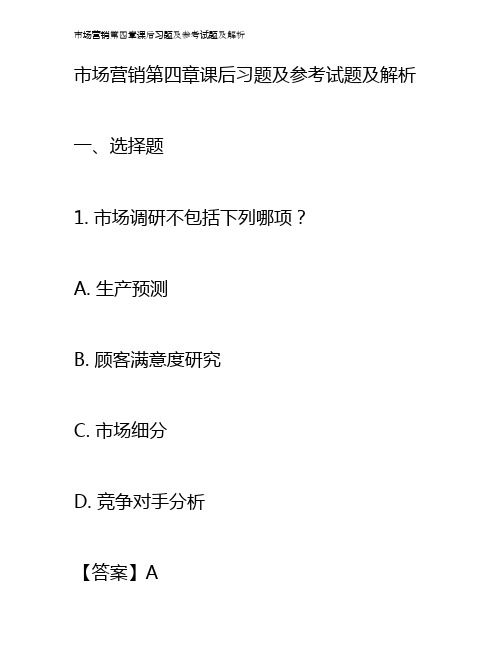
市场营销第四章课后习题及参考试题及解析一、选择题1. 市场调研不包括下列哪项?A. 生产预测B. 顾客满意度研究C. 市场细分D. 竞争对手分析【答案】A【解析】市场调研的基本任务是收集并分析市场信息,以为企业决策提供有关的市场情报。
市场调研包括市场细分、顾客满意度研究、竞争对手分析等方面,但不包括生产预测。
2. 市场推广方案的建立应考虑的因素不包括下列哪一项?A. 产品定价B. 促销方案C. 渠道选择D. 固定资产投资【答案】D【解析】市场推广方案建立时,应考虑的因素包括产品定价、促销方案、渠道选择、市场营销人员策略等,而固定资产投资不在建立市场推广方案时考虑的因素之列。
3. 消费者行为的三个层次是?A. 意愿、行动、反馈B. 知觉、态度、记忆C. 需求、购买、评价D. 欲望、需求、需求涵盖【答案】D【解析】消费者行为的三个层次是欲望、需求、需求涵盖。
欲望是指对现实生活状态的期望,需要是欲望的客观表现,涵盖的是需要的内容。
4. 以下哪种市场定位是以企业自身的资源特点来定位产品?A. 消费者特征定位B. 市场细分定位C. 竞争对手定位D. 产品特性定位【答案】D【解析】产品特性定位是以产品本身的特点和企业自身的资源特点来定位产品的。
消费者特征定位是以消费者的特点来定位产品,市场细分定位是以市场细分来定位产品,竞争对手定位是以竞争对手的情况来定位产品。
5. 新产品市场营销战略中,市场导向战略属于哪一种?A. 不同化策略B. 市场占有率策略C. 市场导向策略D. 导向创新策略【答案】C【解析】市场导向战略是以市场为导向,以满足市场需求为中心来制定战略。
它与销售导向和产品导向不同,分别以销售和产品为导向来制定战略。
不同化策略是指竞争者采用不同的方式在同一市场上从事不同的活动,从而达到不同的目标。
市场占有率策略是指通过提高市场份额来扩大市场规模和降低成本,以增加企业盈利。
导向创新策略是指从市场需求出发,开发出符合市场需求的创新产品。
市场营销课后思考题答案二到十四章

第二章:市场营销管理哲学及其贯彻1.试评述市场营销的管理导向及其意义。
答:市场营销的管理导向是需求管理,其意义通过营销调研、方案、执行而控制来管理目标市场的需求水平、时机和构成,以到达企业目标。
3.市场营销管理的新、旧观念的最根本区别是什么?为什么?答:市场营销管理的新、旧观念的最根本区别是旧观念是以企业为中心,而新观念是以消费者和社会长远利益为中心的。
4.什么是顾客满意?企业要从哪些方面做出努力去到达顾客满意?答:顾客满意是指顾客将产品和效劳满足其需要的绩效与期望进展比拟所形成的感觉状态。
企业从增加顾客购置总价值,减少顾客购置总本钱去到达顾客满意。
5.评述价值链理论及其对企业营销的指导意义?答:价值链理论是指企业建立高度的顾客满意,要求企业创造更多的顾客认知价值。
为此,企业必须系统协调创造价值的各分工部门〔即企业价值链〕以及由供给商、分销商和最终顾客组成的供销价值链的工作,到达顾客与企业利益最大化。
价值链理论对企业营销的指导意义:价值链的各个环节相互关联、相互影响。
要创造顾客高度满意,需要价值链成员的共同努力。
6.试论企业组织改革在全面贯彻现代市场营销管理观念中的作用。
答:面对快速变化的市场环境挑战,企业实现顾客满意还必须改革自身组织与管理体制,成为真面向市场的组织。
市场导向的组织创新的主要原则包括:满足主要利益方〔顾客,供给商、经营商、企业员工和股东〕的要求;改进关健业务过程,使企业创造顾客满意的总目标能有效普及整个业务环节和全过程;形成合理配置资源机制,使企业的有限资源按顾客满意方式有效配置根据这些原则,企业需要建立以信息为根底的知识型组织。
这种新的组织必须保证企业能迅速、有效地倾听市场外的各种信号,并能从听取的信息及业务经历中不断地学习和更新组织知识状态,提高适应市场的能力。
组织倾听和学习的结果,要进一步落实到决策和领先上。
第三章:规划企业战略与市场营销管理1.总体战略、经营战略与职能战略是什么关系?答:总体战略又称公司战略,是企业最高层的战略。
市场营销复习资料带答案---第4章 复习题

第四章市场营销战略规划一、单项选择题:1、下列选项中不属于战略业务单位特征的是( C )。
A、是一项独立的业务B、有专门的经理对其负责C、与企业其他业务密切相关D、有自己的一组竞争者2、一家化妆品企业在规定企业任务时为了体现市场导向,比较可行的提法是( D )。
A、本企业制造化妆品B、本企业的任务是:出售美的希望C、本企业的任务是创造利润D、本企业的任务是满足顾客的美容需要3、生产海尔冰箱的海尔集团推出海尔空调,其发展新业务的战略属于( C )。
A、同心多角化B、水平多角化C、集团多角化D、垂直多角化5、武汉啤酒厂采取种种措施在现有的湖北市场上扩大该厂行吟阁啤酒的销售,这属于(D )战略。
A、市场开发B、产品开发C、规模经营D、市场渗透6、星巴克在当前的市场区域开设新店,方便更多的顾客惠顾,它实施的是(C )。
A、市场开发B、产品开发C、市场渗透D、多角化7、某实力雄厚的大型汽车公司兼并了若干个弱小汽车公司,它的这种增长战略是(A )。
A、前向一体化B、后向一体化C、水平一体化D、同心多元化8、汽车厂收购或兼并轮胎厂是实现( B )战略的表现。
A、前向一体化B、后向一体化C、横向一体化D、横向多角化9、某食品加工厂通过合资经营的方式建立原材料生产基地,这种业务增长方式属于( B )。
A、前向一体化B、后向一体化C、水平一体化D、水平多角化10、服装制造厂收购或兼并纺织厂是实施_________战略的表现。
( B )A、前向一体化B、后向一体化C、横向一体化D、横向多角化11、“欧莱雅”化妆品公司兼并了“美宝莲”化妆品公司,这属于( C )发展战略。
A、前向一体化B、后向一体化C、水平一体化D、同心多角化12、长虹集团利用原有的技术、经验发展并增加了彩电的种类和品种,这种做法是( B )。
A、水平多角化B、同心多角化C、集团多角化D、产品开发13、生产容声牌冰箱的广东科龙公司1993年投资建成了空调器厂,这种发展新业务的方式属于( B )。
市场营销学网上作业第1-4章答案

市场营销学网上作业第1-4章答案一、单项选择题第1章市场营销学的由来与市场观念的演进1、市场营销观念的中心是( [1] )。
A推销已经生产出来的产品B发现需求并设法满足它们C制造质优价廉的产品D制造大量产品并推销出去答案:B2、营销在公司中最理想的地位是( [1] )。
A作为一个比较重要的功能B作为主要功能C作为核心功能D作为整体功能答案:D3、市场营销的核心是( [1] )。
A生产B分配C交换D促销答案:C4、一种观点认为,只要企业能提高产品的质量、增加产品的功能,便会顾客盈门。
这种观念就是( [1] ) A生产观念B产品观念C推销观念D市场营销观念答案:B5、市场营销学作为一门独立学科出现是在( [1] )。
A20世纪50年代B20世纪初C20世纪70年代D18世纪中叶答案:B第2章市场分析与研究6、北京某公司利用技术方面的优势,既经营计算机、光电产品、化工产品,又经营体育用品、室内装饰、专利事务所以及某品牌饮料,它们的这种策略就是( [1] )。
A产品开发B市场开发C同心多角化D复合多角化答案:D7、市场营销组合是指( [1] )。
A对企业微观环境因素的组合B对企业宏观环境因素的组合C对影响价格因素的组合D对企业可控的各种营销因素的组合答案:D8、某养鸡厂开烤鸡店,这就叫( [1] )。
A前向一体化B后向一体化C水平一体化D多角化答案:A9、对B类(又叫明星类)的业务单位,可供选择的投资策略应是( [1] )。
A发展策略B维持策略C收缩策略D放弃策略答案:A10、“适应企业界解决问题的需要”,这是IBM公司为自己规定的( [1] )。
A企业的短期目标B企业的任务C企业的经营策略D企业的计划答案:B第3章市场营销环境11、市场营销环境是影响企业营销活动的( [1] )的因素和力量,包括宏观环境和微观环境。
A可改变B不可控制C可控制D不可捉摸答案:B12、某种产品面临“需求衰退”,出现销售下降,企业应及时采取措施刺激人们对该产品的兴趣,这就是( [1] )。
市场营销学教案 第4章 目标市场与市场定位

主讲:彭石普
第4章 市场细分与目标市场 定位 4.1 市场细分
目录
4.2 4.3
选择目标市场 市场定位
学习目标
理论目标:
学习和把握市场细分的概念与作用,市场细分的理论依据,选择目标 市场的条件和目标市场定位概念等陈述性知识;能用所学理论知识指导 “市场细分与目标市场定位”的相关认知活动。
4.1市场细分
4.1.2 市场细分的原则和标准 1)原则 衡量性 盈利性 进入性 稳定性
【业务链接4-1】 福特汽车公司的侏儒特制汽车构想
福特汽车公司为了更好地满足了特殊消费者的需求, 在50年代曾经打算专门为1.2m以下的侏儒生产特制
汽车,但这需要特殊的产品设计、与大众化汽车生
产不同的生产线及工装设备,这必然造成成本的大 量增加。 通过市场调研与细分后,发现这一汽车细分市场的 需求极其有限,人口较少,盈利前景暗淡,最终放
为过分的细分市场,繁复的选择容易造成消费者的麻烦,最后降 低了顾客对品牌的忠诚度,这样细分的结果可能得不偿失。例如, 顾客去买可乐时说:“老板给我瓶可乐”,老板问:“百事还是 可口可乐?”顾客:“可口可乐”,老板又问:“一般的还是加 料的?”顾客说:“加料的”,老板又问:“是草莓的、苹果的
还是樱桃的?”顾客说:“樱桃的”,老板又问:“是健怡可乐 还是传统可乐”,消费者说:“干脆给我一瓶百事算了!”
【同步思考4-1】
可口可乐对其产品是否需要如此细分?
可口可乐为了细分市场,曾把其可乐产品口味分成一般的和加料 的。加料的又分成:苹果口味,香草口味,樱桃口味。这三种口
味的可乐产品又细分成健怡可乐和传统风味的。
分析说明:可口可乐对其产品是否需要如此细分?为什么? 分析要点:我认为可口可乐对其产品没有必要如此进行细分。因
《市场营销原理与实务》参考答案.
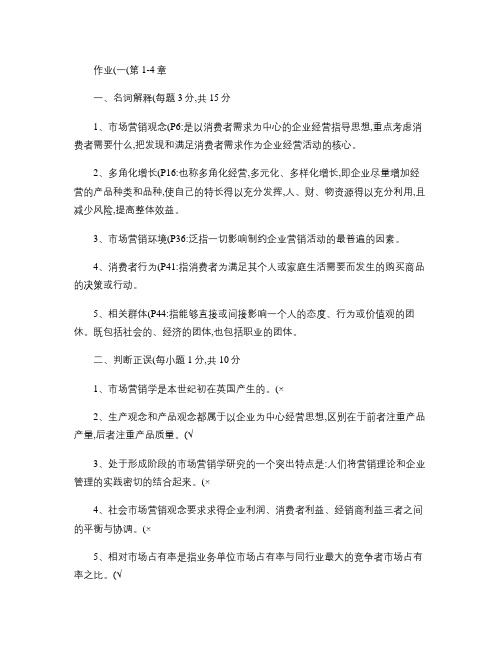
作业(一(第1-4章一、名词解释(每题3分,共15分1、市场营销观念(P6:是以消费者需求为中心的企业经营指导思想,重点考虑消费者需要什么,把发现和满足消费者需求作为企业经营活动的核心。
2、多角化增长(P16:也称多角化经营,多元化、多样化增长,即企业尽量增加经营的产品种类和品种,使自己的特长得以充分发挥,人、财、物资源得以充分利用,且减少风险,提高整体效益。
3、市场营销环境(P36:泛指一切影响制约企业营销活动的最普遍的因素。
4、消费者行为(P41:指消费者为满足其个人或家庭生活需要而发生的购买商品的决策或行动。
5、相关群体(P44:指能够直接或间接影响一个人的态度、行为或价值观的团休。
既包括社会的、经济的团体,也包括职业的团体。
二、判断正误(每小题1分,共10分1、市场营销学是本世纪初在英国产生的。
(×2、生产观念和产品观念都属于以企业为中心经营思想,区别在于前者注重产品产量,后者注重产品质量。
(√3、处于形成阶段的市场营销学研究的一个突出特点是:人们将营销理论和企业管理的实践密切的结合起来。
(×4、社会市场营销观念要求求得企业利润、消费者利益、经销商利益三者之间的平衡与协调。
(×5、相对市场占有率是指业务单位市场占有率与同行业最大的竞争者市场占有率之比。
(√6、宏观营销环境大致包括五个方面内容;政治环境、竞争环境、经济环境、法律环境、科技环境、社会文化环境等。
(×7、消费者行为的直接原因是动机,可以把动机概括为两部分,即生理动机和心理动机。
(√8、国外一些厂商常花高价请明星们穿用他们的产品,可收到显著的示范效应。
这是利用了相关群体对消费者的影响。
(√9、生产资料购买行为可分为三种类型,即经常性购买、选择性购买和探究性购买。
(×10、消费需求变化中最活跃的因素是个人可以任意支配的收入。
(√三、单项选择(每小题2分,共20分1、市场营销学的发展历史大致可分为四个阶段,其中初创阶段是在(BA、18世纪中叶B、19世纪末至20世纪30年代C、本世纪50年代D、19世纪初2、市场营销观念的中心是( B 。
国际市场营销 全球营销学每章课后习题答案
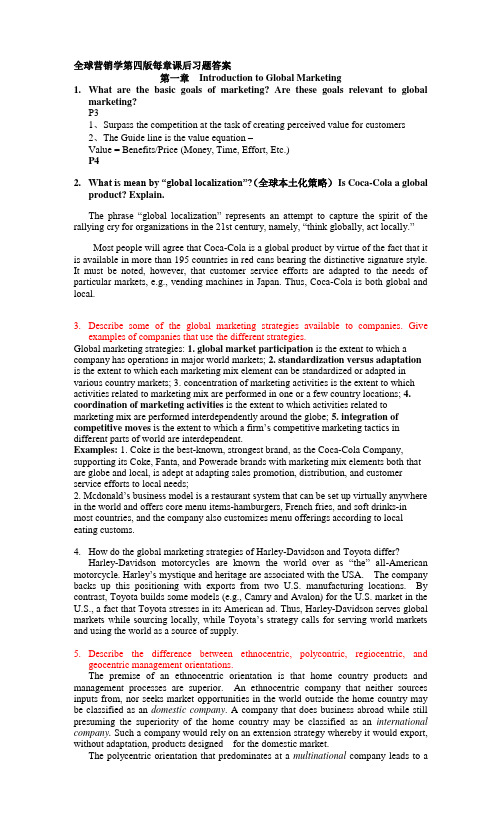
全球营销学第四版每章课后习题答案第一章Introduction to Global Marketing1.What are the basic goals of marketing? Are these goals relevant to globalmarketing?P31、Surpass the competition at the task of creating perceived value for customers2、The Guide line is the value equation –Value = Benefits/Price (Money, Time, Effort, Etc.)P42.What is mean by “global localization”?(全球本土化策略)Is Coca-Cola a globalproduct? Explain.The phrase “global localization” represents an attempt to capture the spirit of the rallying cry for o rganizations in the 21st century, namely, “think globally, act locally.”Most people will agree that Coca-Cola is a global product by virtue of the fact that it is available in more than 195 countries in red cans bearing the distinctive signature style. It must be noted, however, that customer service efforts are adapted to the needs of particular markets, e.g., vending machines in Japan. Thus, Coca-Cola is both global and local.3.Describe some of the global marketing strategies available to companies. Giveexamples of companies that use the different strategies.Global marketing strategies: 1. global market participation is the extent to which a company has operations in major world markets; 2. standardization versus adaptation is the extent to which each marketing mix element can be standardized or adapted in various country markets; 3. concentration of marketing activities is the extent to which activities related to marketing mix are performed in one or a few country locations; 4. coordination of marketing activities is the extent to which activities related to marketing mix are performed interdependently around the globe; 5. integration of competitive moves is the extent to which a firm’s competitive marketing tactics in different parts of world are interdependent.Examples: 1. Coke is the best-known, strongest brand, as the Coca-Cola Company, supporting its Coke, Fanta, and Powerade brands with marketing mix elements both that are globe and local, is adept at adapting sales promotion, distribution, and customer service efforts to local needs;2. Mcdonald’s business model is a restaurant system that can be set up virtually anywhere in the world and offers core menu items-hamburgers, French fries, and soft drinks-in most countries, and the company also customizes menu offerings according to local eating customs.4.How do the global marketing strategies of Harley-Davidson and Toyota differ?Harley-Davidson motorcycles are known the world over as “the” all-American motorcycle. Harley’s mystique and heritag e are associated with the USA. The company backs up this positioning with exports from two U.S. manufacturing locations. By contrast, Toyota builds some models (e.g., Camry and Avalon) for the U.S. market in the U.S., a fact that Toyota stresses in its American ad. Thus, Harley-Davidson serves global markets while sourcing locally, while Toyota’s strategy calls for serving world markets and using the world as a source of supply.5.Describe the difference between ethnocentric, polycontric, regiocentric, andgeocentric management orientations.The premise of an ethnocentric orientation is that home country products and management processes are superior. An ethnocentric company that neither sources inputs from, nor seeks market opportunities in the world outside the home country may be classified as an domestic company. A company that does business abroad while still presuming the superiority of the home country may be classified as an international company. Such a company would rely on an extension strategy whereby it would export, without adaptation, products designed for the domestic market.The polycentric orientation that predominates at a multinational company leads to aview of the world in which each country markets is different from the others. Local country managers operating with a high degree of autonomy adapt the marketing mix in a polycentric, multinational company. Managers who are regiocentric or geocentric in their orientations recognize both similarities and differences in world markets. Market opportunities are pursued using both extension and adaptation strategies. The regiocentric and geocentric orientations are characteristic of global transnational companies.OrEthnocentric orientation: home country is superior to the rest of the world, sees similarities in foreign countries,leads to a standardized or extension approach; Polycentric orientation: the opposite of ethnocentrism, each country in which a company does business is unique, sees differences in foreign countries, leads to localized or adaption approach; Regiocentric orientation: a region becomes the relevant geographic unit; management`s goal is to develop an integrated regional strategy; Geocentric orientation:views the entire world as a potential market and strives to develop integrated world market strategies.6.Identify and briefly describe some of the forces that have resulted in increased globalintegration and the growing importance of global marketing.P21+Driving Forces:Regional economic agreements、Market needs and wants、TechnologyTransportation and communication improvements、Product development costs、Quality、World economic trends、LeverageRestraining Forces:Management myopia、Organizational culture、National controls 7.Define leverage and explain the different types of leverage utilized by companieswith global operations.Define leverage:P25第二章The Global Economic Environment1.Explain the difference between market capitalism, centrally planned capitalism,centrally planned socialism, and market socialism. Give an example of a country that illustrates each types of system.Market capitalism is an economic system in which individuals and firms allocate resources and production resources are privately owned. (England).Centrally planned capitalism is an economic system in which command resource allocation is utilized extensively in an environment of private resource ownership. (Sweden)Centrally planned socialism, in this type of economic system, the state has broad powers to serve the public interest as it sees fit. (Former Soviet Union)Market socialism, in such a system, market allocation policies are permitted within an overall environment of state ownership. (China)2.What is a BEM? Identify the BEMs according to their respective stages of economicdevelopment.P53P56-583. A manufacture of satellite dishes is assessing the world market potential for hisproducts. He asks you if he should consider developing countries as potential markets.How would you advise him?Despite the difficult economic conditions in parts of developing countries, many nations will involve into attractive markets.One of marketing’s roles in developing countries is to focus resources on the task of creating and delivering products that are best suited to local needs and incomes. The role of marketing to indentify people’s needs and wants is the same in all countries, irrespective of level of economic development. It is also an opportunity to help developing countries join the information age.And P654.Turn to the Index of Economic Freedom (Table 2-1) and identify where the BEMs areranked. What does the result tell you in terms of the relevance of the index to global marketers?P52第三章Social and Cultural Environments1.What are some of the elements that make up culture? How do these find expression inyour native culture?Culture is a collection of Values, beliefs, behaviors, customs, and attitudes that distinguish one society from another.Culture is acted out in social institutions, such as, family, education, religion, government, business.2.What is the difference between a low-context culture and a high-context culture?Give an example of a country that is an example of each type and provide evidence for your answer.PPT 第四章4-63.How can Hofstede’s cultural typologies help Western marketers better understandAsian culture?P874.Explain the self-reference criterion(自我参照准则). Go to the library and findexamples of product failures that might have been avoided through the application of the SRC.Unconscious reference to one’s own cultural values; creates cultural myopia5.Briefly explain the social research of Everrtt Rogers regarding diffusion ofinnovations,……P94pare and contrast USA and Japan in terms of traditions and organizationalbehavior and norms.第四章The Legal and Regulatory Environments of Global Marketing1.What is sovereignty? What is it an important consideration in the politicalenvironment of global marketing?sovereignty2.Describe some of the sources of political risk. Specially, what forms can political risktake?Tension between aspirations and realityPrimarily occurs in lower and lower-middle income countries–Indonesia and economic crisisWhen political risk occurs in high income countries, it is generally due to a long-standing conflict–Northern IrelandP1423.Briefly describe some of the differences between the legal environment of a countrythat embraces common law and one that observes civil law.4.Global marketers can avoid legal conflicts by understanding the reasons conflictsarise in the first place. Identify and describe several legal issues that relate to global commerce.Intellectual PropertyAntitrustContractualLicensing and Trade Secrets5.“See you in court” is one way to respond when legal issues arise. What otherapproaches are possible?LitigationFormal arbitration–Settles disputes outside of court–Groups agree to abide by panel’s decision1958 United Nations Convention on the Recognition and Enforcement of Foreign Arbitral Awards–Most important treaty regarding international arbitration第五章Global Information Systems and Market Research1.Explain two information technology puts powerful tools in the hands of globalmarketers.Modern IT tools provide the means for a company's marketing information system and research functions to provide relevant information in a timely, cost –efficient, and actionable manner.Electronic data interchange (EDI) allows business units to submit orders, to issue invoices, to conduct business electronically, Wal-Mart legendary for its EDI, save time and money, enables retailers to improve inventory management. Transaction formats are universalEfficient Consumer Response (ECR) This is in addition to EDI, an effort for retailers and vendors to work closely on stock replenishment(补充). ECR can be defined as a joint initiative by members of a supply chain to work toward improving and optimizing(最优化) aspects of the supply chain to benefit customersIntranet, Electronic Point of Sale (EPOS), Data Warehouses are also helping businesses improve their ability to target consumers and increase loyalty.2.What are the different modes of information acquisition? Which is the most importantfor gathering strategic information?3.4、Outline the basic steps of the market research process.5、What is the difference between existing, latent, and incipient demand? How mightthese differences affect the design of a marketing research project?Demand and profit potential, in turn, depend in part on whether the market being studied can be classifieds existing or potential. Existing markets are those in which customer needs are already being served by one or more companies. In some instances, there is no existing market to research and. information may be readily available. A latent market is in essence, an und iscovered segment .It’s a market in which demand would materialize if an appropriate product were made available. An incipient market is a market that will emerge if particular economic demographic, political, or sociocultural trend continues. A company is not likely to achieve satisfactory results if it offers a product in an incipient market before the trends have taken root.Market growth, brand loyalty, market segment, product, sales promotion, pricing, distribution, will be different in marketing research project.6.Describe some of the analytical techniques used by global marketers. When is it appropriate to use each technique?A number of techniques are available for analyzing survey data.Factor analysis can be used to transform large amount of data into manageable units. It is useful in psychographic segmentation studies or creating perceptual maps; cluster analysis allows the researchers to group variables into clusters that maximize within-group similarities and between-group differences. It can be used to do global marketing research, to perform benefit segmentation, and to identify new product opportunities. Multi dimensional scaling is another technique for creating perceptual maps which is particular useful when there are many product to choose and consumers have difficulty in verbalizing their conceptions. Conjoint analysis is used to gain insights into the combination of features that will be the most attractive to consumers. It is useful when determines the values and utilities of the various levels of product features and plots them graphically.第六章Segmentation, Targeting, and Positioning1.differentiate the five basic segmentation strategies. Give an example of a companythat has used each one.P170-P1831、IncomePopulationsAge distributionGenderEducationOccupation2、Grouping people according to attitudes, value, and lifestyles3、4、Benefit segmentation focuses on the value equation–Value = Benefits / Price5、The population of many countries includes ethnic groups of significant size2.Explain the difference between segmenting and targeting.P200pare and contrast standardized, concentrated, and differentiated global marketing.Illustrate each strategy with an example from a global company.Standardized global marketing is mass marketing on a global scale with undifferentiated target marketing (Revlon International)Concentrated global marketing, involves devising a marketing mix to reach a niche. A niche is simply a single segment of the global market. (Germany`s Winter halter) Differentiated global marketing, represents a more ambitious approach than concentrated target marketing with multi-segment targeting and two or more distinct markets (Rover)4.5.What is positioning? Identify the different positioning strategies presented in thechapter and give examples of companies or products that illustrate each.Locating a brand in consumers’minds over and against competitors in terms of attributes and benefits that the brand does and does not offer.P192-1956.What is global consumer culture positioning? What other strategic positioningchoices do global marketers have?Identifies the brand as a symbol of a particular global culture or segment.P1967.What is high-touch product? Explain the difference between high-tech productpositioning and high-touch product positioning. Can some products be positioned using both strategies? Explain.High-tech products are sophisticated technologically complex, and/or difficult to explain or understand, and frequently evaluated in terms of their performance against established objective standards. High-tech global consumer positioning also works well for special interest products associated with leisure of recreation.High-touch products, consumers are generally energized by emotional motives rather than rational ones, and frequently evaluated in terms of their performance against established subjective, aesthetic terms.Some products can be positioned using both strategies, with both satisfying buyers’ rational criteria and evoking an emotional response. Nokia, for example, combines technical performance with a fashion orientation.第七章Global Market Entry Strategies:1.What are the advantages and disadvantages of using licensing as a market entry tool?Give examples of companies from different countries that use licensing as a global marketing strategy.Advantages to LicensingProvides additional profitability with little initial investmentProvides method of circumventing tariffs, quotas, and other export barriersAttractive ROILow costs to implementDisadvantages to LicensingLimited participationReturns may be lostLack of controlLicensee may become competitorLicensee may exploit company resourcesP2062.What is foreign direct investment? What forms can FDI take?P209Partial or full ownership of operations outside of home countryForms:Joint ventures–Minority or majority equity stakes–Outright acquisition3.Do you agree with Ford’s decision to acquire Jaguar? What was more valuable toFord---the physical assets or the name?P2154.What is meant by the phrase global strategic partnership? In what ways does this formof market entry strategy differ from more traditional forms such as joint ventures? Participants remain independent following formation of the allianceParticipants share benefits of alliance as well as control over performance of assigned tasksParticipants make ongoing contributions in technology, products, and other key strategic areasPPT3055.What are Keiretsu? How does this form of industrial structure affect companies thatcompete with Japan or that are trying to enter the Japanese market?PPT307书P2276.Which Strategic options for market entry or expansion would a small company belikely to pursue? A large company?StrategiesCompanies must decide to expand by:–Seeking new markets in existing countries–Seeking new country markets for already identified and served market segments第八章Product and Brand Decisions1.What is the difference between a product and a brand?A product is a good, service, or ideaBrandsBundle of images and experiences in the customer’s mindA promise made by a particular company about a particular productA quality certificationDifferentiation between competing productsThe sum of impressions about a brand is the Brand ImageThe added value that accrues to a product as a result of investments in the marketing of the brandAn asset that represents the value created by the relationship between the brand and customer over time2.How do local, international, and global products differ? Cite examplesLocal Product is one that has achieved success in a single national market and represents the lifeblood of domestic companies. (Coca-cola, ginseng beverage only in Japan)International product is offered in several markets in a particular region (Euro-product, only in euro zone)Global product meets the wants and needs of a global market and is offered in all world regions (personal stereos)3.What are some of the elements that make up a brand? Are these elements tangible orintangible?IntangibleP2414.What criteria should global marketers consider when making product designdecisions?In many instances, packaging is an integral element of product-related design decisions. Packaging is designed to protect or contain the product during shipping;Labeling provides consumers with various types of information; Aesthetics differ around the world. Global marketers must understand the importance of visual aesthetics; Product Warranties is a written guarantee that assures the buyer is getting what they paid for or provides a remedy in case of a product failure. Warranties can be used as a competitive tool5.How can buyer at titudes about a product’s country of origin affect marketing strategy?买家对于原产国的态度对营销策略有什么影响?Perceptions about and attitudes toward particular countries often extend to products and brands known to originate in those countries–Japan–Germany–France–ItalyP252-2546.Identify several global brands. What are some of the reasons for the global success ofthe brands you chose?Both products and brand are good……7.Briefly describe various combinations of product-communication strategies availableto global marketers. When is it appropriate to use each?Product-communication extension (dual extension) is a strategy selling the same product with the same promotional appeals used in domestically when pursuing opportunities outside the home market. It used frequently with industrial (business to business) products.Product extension-communication adaptation strategy is a relatively low cost of implementation because the physical product is unchanged, and the main costs are associated with market research and revising promotional appeals. It used frequently when consumer conceptions outside the home market are very different from domestic marketProduct adaptation-communication extension is an approach to global product planning is to extend, without change, the basic home-market communications strategy while adapting the product to local use or preference conditions. It used frequently when natural conditions outside the home market are very different from domestic market Product-communication adaptation (dual adaptation) strateg y is an approach used both the different product serves and advertising appeals to consumer receptivity when comparing a new geographic market to the home market, environmental conditions or consumer preferences differ;第九章Pricing Decisions1.What are the basic factors that affect price in any market? What considerations enterinto the pricing decision?In global marketing, the task of setting prices is complicated by fluctuating exchange rates. Currency fluctuations can create significant problems and opportunities for the classic international company that exports from the home country.Inflation, or a persistent upward change in price levels, is a problem in many country markets. It can be caused by an increase in the money supply and currency devaluation. Governmental policies and regulations that affect pricing decisions include dumping legislation, resale price maintenance legislation, price ceilings, and general reviews of price levels.Pricing decisions are bounded not only by cost and nature of demand but also by competitive action.Competitive Behavior: If competitors do not adjust their prices in response to rising costs it is difficult to adjust your price to maintain operating margins; If competitors are manufacturing or sourcing I a lower-cost country, it may be necessary to cut prices to stay competitiveThe global marketer has several options for addressing the problem of price escalation orthe environmental factors described in the last section.2.Define the various types of pricing strategies and objectives available to globalmarketers.Market Skimming and Financial Objectives: Market Skimming charges a premium price which may occur at the introduction stage of product life cyclePenetration Pricing and Non-Financial Objectives: Penetration Pricing charges a low price in order to penetrate market quickly which appropriates to saturate market prior to imitation by competitors3.Identify some of the environmental constraints on global pricing decisions. Currency FluctuationsInflationary EnvironmentGovernment Controls, Subsidies, RegulationsCompetitive BehaviorSourcing4.Why do price differences in world markets often lead to gray marketing?Because price differences in world markets lead to trademarked products are exported from one country to another where they are sold by unauthorized persons or organizationsGray marketing occurs when product is in short supply, when producers use skimming strategies in some markets, and when goods are subject to substantial mark-ups 5.What is dumping? Why was dumping such an important issue during the UruguayRound of GATT negotiations?Sale of an imported product at a price lower than that normally charged in a domestic market or country of origin.P2966.What is transfer price? Why is it an important issue for companies with foreignaffiliates(外国子公司)? Why did transfer pricing in Europe take on increased importance in 1999?The transfer price is that Pricing of goods, services, and intangible property bought and sold by operating units or divisions of a company doing business with an affiliate in another jurisdiction.P2997.What is the difference between ethnocentric, polycontric, and geocentric pricingstrategies? Which one would you recommend to a company that has global market aspirations?P291-292 PPT240-242pare and contrast the different forms of countertrade.Countertrade occurs when payment is made in some form other than moneyOptions–BarterThe least complex and oldest form of bilateral, non-monetary counter-tradeA direct exchange of goods or services between two parties–Counter-purchase P303-304–Offset–Compensation trading–Cooperation agreements–Switch trading第十章Global Marketing Channels and Physical Distribution1.In what ways can channel intermediaries create utility for buyers?ObjectivesMarketing channels exist to create utility for customers–Place utility -availability of a product or service in a location that is convenient to a potential customer–Time utility -availability of a product or service when desired by a customer–Form utility -availability of the product processed, prepared, in proper condition and/or ready to use–information utility -availability of answers to questions and general communicationabout useful product features and benefits2.What factors influence the channel structures and strategies available to globalmarketers?B2CThe characters of both buyers and products have an important influence on channel design.The number of individual buyers and their geographic distribution, income, shopping habits and different channel approaches.Products characters such as degree of standardization, perishability, bulk, service requirements, and unit price have an impact as well.Channels tends to be longer as the number of consumers to be served increases and the price per unit decreases. Bulky products usually require channel arrangements that minimize the shipping distances and the number of times products change hands before they reach the ultimate customer.B2BAs is true with consumer channels, product and consumer characteristics have an impact on channel structure. Three basic elements are involved: the manufacture's sales force, distributors or agents and wholesalers.Channel strategy in a global marketing program must fit the company's competitive position and overall marketing objectives in each national market.market factors: consumer profiles, market size and location of country.3.What is cherry picking? What approaches can be used to deal with this problem?P323pare and contrast the typical channel structures for consumer products andindustrial products.P340 PPT252-2555.Identify the different forms of retailing and cite an example of each form. Identifyretailers from as many different countries as you can.PPT258-259 P3256.Identify the four retail market expansion strategies discussed in the text. What factorsdetermine the appropriable mode?Organic–Company uses its own resources to open a store on a green field site or acquire one or more existing retail facilitiesFranchise–Appropriate strategy when barriers to entry are low yet the market is culturally distant in terms of consumer behavior or retailing structuresChain Acquisition–A market entry strategy that entails purchasing a company with multiple existing outlets in a foreign countryJoint Venture–This strategy is advisable when culturally distant, difficult-to-enter markets are targeted 7.What special distribution challenges exist in Japan? What is the best way for anon-Japanese company to deal with these challenges?第十一章Global Marketing Communications Decisions:Advertising and Public Relations1.In what ways can global brands and global advertising campaigns benefit a company? P3482.How does the “standardized versus localized” debate apply to advertising?Four difficulties that compromise an organization’s communicat ion efforts–The message may not get through to the intended recipient.–The message may reach the target audience but may not be understood or may even be misunderstood.–The message may reach the target audience and may be understood but still may not induce the recipient to take the action desired by the sender.–The effectiveness of the message can be impaired by noise.。
市场营销(第四版_毕思勇)习题答案47630
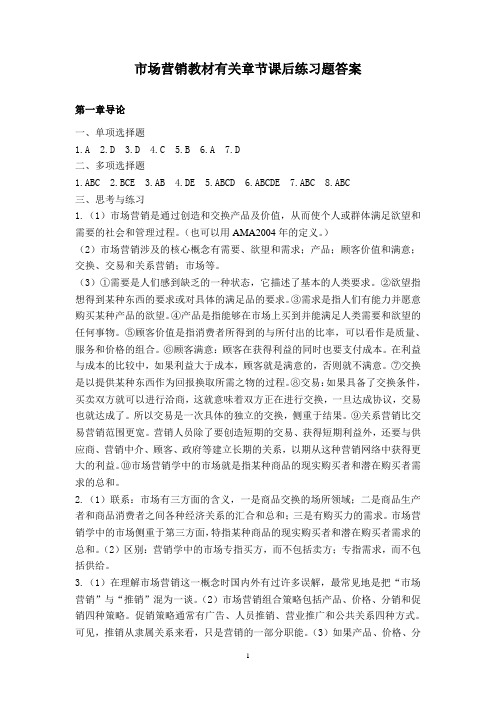
市场营销教材有关章节课后练习题答案第一章导论一、单项选择题1.A2.D3.D4.C5.B6.A7.D二、多项选择题1.ABC2.BCE3.AB4.DE5.ABCD6.ABCDE7.ABC8.ABC三、思考与练习1.(1)市场营销是通过创造和交换产品及价值,从而使个人或群体满足欲望和需要的社会和管理过程。
(也可以用AMA2004年的定义。
)(2)市场营销涉及的核心概念有需要、欲望和需求;产品;顾客价值和满意;交换、交易和关系营销;市场等。
(3)①需要是人们感到缺乏的一种状态,它描述了基本的人类要求。
②欲望指想得到某种东西的要求或对具体的满足品的要求。
③需求是指人们有能力并愿意购买某种产品的欲望。
④产品是指能够在市场上买到并能满足人类需要和欲望的任何事物。
⑤顾客价值是指消费者所得到的与所付出的比率,可以看作是质量、服务和价格的组合。
⑥顾客满意:顾客在获得利益的同时也要支付成本。
在利益与成本的比较中,如果利益大于成本,顾客就是满意的,否则就不满意。
⑦交换是以提供某种东西作为回报换取所需之物的过程。
⑧交易:如果具备了交换条件,买卖双方就可以进行洽商,这就意味着双方正在进行交换,一旦达成协议,交易也就达成了。
所以交易是一次具体的独立的交换,侧重于结果。
⑨关系营销比交易营销范围更宽。
营销人员除了要创造短期的交易、获得短期利益外,还要与供应商、营销中介、顾客、政府等建立长期的关系,以期从这种营销网络中获得更大的利益。
⑩市场营销学中的市场就是指某种商品的现实购买者和潜在购买者需求的总和。
2.(1)联系:市场有三方面的含义,一是商品交换的场所领域;二是商品生产者和商品消费者之间各种经济关系的汇合和总和;三是有购买力的需求。
市场营销学中的市场侧重于第三方面,特指某种商品的现实购买者和潜在购买者需求的总和。
(2)区别:营销学中的市场专指买方,而不包括卖方;专指需求,而不包括供给。
3.(1)在理解市场营销这一概念时国内外有过许多误解,最常见地是把“市场营销”与“推销”混为一谈。
- 1、下载文档前请自行甄别文档内容的完整性,平台不提供额外的编辑、内容补充、找答案等附加服务。
- 2、"仅部分预览"的文档,不可在线预览部分如存在完整性等问题,可反馈申请退款(可完整预览的文档不适用该条件!)。
- 3、如文档侵犯您的权益,请联系客服反馈,我们会尽快为您处理(人工客服工作时间:9:00-18:30)。
《市场营销实训》(第二版)参考答案第4章参考答案任务一<案例练习>1.答:C2.答:C3.答:AB4.答:⑴2004年金猴皮鞋相对市场占有率=6.3%/7.1%=0.89⑵皮鞋行业平均年增长率=8%⑶根据金猴皮鞋的相对市场占有率与皮鞋行业年平均增长率指标值,及企业的经营规模,可定位在波士顿咨询公司的成长——份额矩阵的第四象限,即金猴皮鞋属于奶牛类产品。
金猴集团可以不必再大量投资,而是享有现有的规模经济效益。
5.答:⑴内容提要。
⑵背景或现状。
⑶机会与问题分析。
⑷营销目标。
⑸制定营销战略。
⑹确定市场营销战术。
⑺营销预算。
⑻营销计划控制。
<综合训练>1.答:C2.答:AB3.答:AB4.答:A5.答:1)强化产品功能演示2)小店拜访3)店主关系管理4)店主联谊会⑸促销支持任务二**豆奶市场营销策划方案一、现阶段利乐包豆奶市场环境分析上海市区人口1200万,是我国最重要的商业城市,市场潜力大,竞争品牌多。
近年来豆奶类饮品在居民心中不断上升的消费地位和上海独特的快节奏生活方式,给营养绿色饮料带来巨大的商业机遇。
仅香港维他豆奶1998年在上海的销售额就高达5000万元人民币。
1.竞争品牌占有率分析目前利乐包豆奶在上海市场同类产品众多,其中尤以香港维他奶销售最为看好。
该产品占有豆奶利乐包市场实际销售额的60%以上,月均销售在400万元以上。
该产品是成熟期的品牌产品,在上海营销广告方式设计专业,营销渠道成熟,市场占有率极高,售点形象设计良好,是上海豆奶利乐包的主导品牌。
在上海豆奶利乐包产品中,销售仅次于维他奶的正广和,以都市为主导营销品牌,也吸引了部分潮流青年,销售情况日趋上升。
同时,上海光明、全仕奶、杨协成各自营造的不同消费群体,也占有一定的市场份额,形成以下群雄割据的局面。
主导品牌:维他奶、维他麦精朱古力。
有影响品牌:正广和都市奶、正广和纯豆浆、杨协成豆奶、上海光明利乐包、全仕奶利乐包。
上海豆奶利乐包销售品牌排序:维他奶、正广和、杨协成、光明、全仕。
2.竞争产品价格及容量分析上海利乐包豆奶从包装上主要分为两种类型,适用家庭饮用的1000ml左右容量和适用于普通随机消费的250ml左右容量。
从价格分析,随机消费型产品市场零售价在1.3—1.5元之间;家庭饮用型价格差异大,由于同我们产品不在同一容量等级,本企划案不做重点分析。
3.竞争品牌广告促销历史资料电视广告:维他奶、正广和瞄准黄金时段播出的收视率极高的娱乐节目:欢乐总动员、相约星期六、快乐大转盘、幸福快车、五星奖合成大擂台;少儿喜爱的快活蹦蹦跳、智力大冲浪。
在节目之前、中间插播广告,平均每天一种产品四次广告。
其它广告形式多样:公交车体广告、出租车尾粘贴广告。
在人流量大的高架路边、地铁、车站、高速公路、交警岗亭等地方做显眼的灯箱。
给店铺做门头。
还有广告伞、衬衫、气球、横幅。
另外,他们也非常重视电台、报纸、杂志等媒介。
主要品牌价格分析表品牌品种容量市场零保价维他奶维他奶100ml 0.80元维他奶维他奶250ml 1.30元麦精朱古力250ml 1.30元正广和都市奶 250ml 1.50元杨协成豆奶250ml 2.00元巧克力牛奶200ml 2.00元上海光明纯鲜牛奶200ml 2.00元上海光明纯鲜牛奶250ml 2.00元4.从竞争环境分析营销机会点综合以上营销环境分析,维维豆奶要迅速在上海市场上市推广,必须同等价位渗透市场,利用维维品牌的知名度,通过有针对性的广告宣传,引发消费者首次购买欲望。
通过大面积的铺货和有吸引力的营销政策及售点营销氛围推广产品。
二、上海市场直销运作对产品推广的机会与缺陷上海市场销售网络发达,经过半年多的直销实践,目前豆奶销售基本分为5条直销体系,即与6家大型卖场、8家连锁超市公司、4家便利店配送公司、几十家百货商场、交易市场主要批发商建立业务关系。
这种营销渠道的建立,对维维利乐包迅速进入非常有利,能在短时间内使产品迅速摆上1000家以上大中型售点的柜台。
这种营销体系对豆奶饮料而言,缺乏街头冰点销售体系,对豆奶饮料的推广是一个障碍。
三、问题点与机会点综合分析利乐包推广的问题点:1.产品价格高。
同类产品的零售价仅在1.3元左右;2.无冰点销售网络;3.产品无知名度;4.竞争环境激烈;5.营销费用大,产品单位成本高;6.无针对上海市场的广告宣传重点。
利乐包推广的有利条件:1.交易市场、大卖场、连锁超市、百货店、便利店渠道畅通;2.企业知名度高;3.新产品有第一次购买机会;4.企业有推广实力。
四、销售价格定位由于上海市场独特的营销环境,维维利乐包的商业供货价应定在X元/包较为适宜。
通过商场利润加价,产品零售价不超过Y[,1]元,冰点售价不超过Y[,2]元。
上海市场是纯粹的直销运作,各类型网点的直销供货价及产品零售价应控制在一定范围内。
五、销售渠道设计1.第一种销售渠道1)充分利用现有直销优势及良好的网络体系,迅速占领交易市场,连锁超市、大卖场、连锁便利店的1229个店面柜台。
2)尽可能多的同81家百货商场发生业务关系,作好产品上柜。
2.第二种销售渠道以行政区或街道为单位寻找新的专业雪糕、冷饮批发商,建立冰点网络系统。
3.第三种销售渠道以寻找集团消费为重点,主要作三条线:A、效益良好的企业防暑降温品;B、中午办公室午餐的写字楼;C、学校;D、面包房、娱乐场所。
六、营销目标1.市场占有率:X%2.焦点覆盖率大卖场 100%连锁超市 80%以上连锁便利店 80%以上百货商场 60%以上冰点 50%以上3.广告宣传目标产品尝试率30%品牌知名度40%4.短期销售行为至1999年11月产品销售X万箱。
七、广告宣传组合1.品牌定位:“解渴+营养”,纯天然营养时尚饮品。
质量承诺:维维利乐包豆奶是中国最大的豆奶生产企业提供给消费者的高质量产品。
品牌承诺:以中国豆奶行业最具价值的“维维”为主品牌。
差别化策略:解渴+营养双重功效早餐饮用品。
2.营销组合:以电视广告及初期焦点促销为主,辅以报纸功能性介绍及其他宣传,全面推广产品。
3.电视媒介:一般来说,对观众产生影响的最少暴露频次是3+(3次以上),能让目标观众回忆起来的最少暴露频次是6+,在广告周期内,需要更多的暴露频次超过其他品牌,8+至10+的暴露频次是需要的。
在维他奶已居领导地位的市场环境下,集团应从4 月中旬起通过强有力的宣传辅以有力度的市场铺货挑战市场。
广告周期:1999年X月Y日——1999年X月Y日。
广告播出原则:A、现有豆奶广告全部换为豆奶饮料广告;B、对维他奶广告采用一前一后夹击方式播出。
C、选择收视率高的栏目,做成维维豆奶的宣传内容,栏目版头以5秒产品形象片方式播出,中间夹15 秒产品功能片、或5秒形象片和15秒功能片连续播出;D、每天投播不少于6次。
4.售点广告营造气氛1)由于上海市区面积大,商业网点分散平均,不可能进行全面开花式的售点广告,建议以上海四条最繁华路段及最繁华商业区为主要广告点进行售点广告宣传,起到以点带面的作用。
2)区域选择:繁华街道:南京路、淮海路、四川路、西藏路;繁华商业区:徐家汇、打浦桥、曹家渡、五角场。
3)方式:A、每条街道每个商业区选择25个大型冰柜摊点,提供外观类似于利乐包饮料的冰柜和维维遮阳伞;B、每家摊点交X元押金;C、每个摊点在12月前销售利乐包及系列饮料X箱以上,冰柜赠给摊点使用,且2000年能销售X件以上者退回所交押金;D、现场提供多种类型的宣传品。
5.报纸媒介6.其他媒介八、促销组合1.售点长期促销:捆绑式销售具体办法:1)通过销售协助,在每一个豆奶广告袋内装X包利乐包产品以每袋Y元的价格出售。
2)每单位包标价Z元,对外宣传4赠2即每4 袋利乐包送一袋相同产品,和一个精美手提袋。
3)单包购按商场Z元价格执行。
4)商场结算以广告袋数量和实际回款相结合的办法执行。
5)单独派出巡视员进行专业理货。
促销时间:X月Y日——X月Y日售点选择:大卖场、连锁超市、便利店1000家售点。
2.人员推销:以街道区域为单位划分50个区域,每个区域内招聘100 名下岗女工,逐个冰点进行铺货。
铺货目标3000家冰点。
3.营业推广:1)将液体饮料同果汁饮料纳入同一销售网络。
2)上市之初开展为期30天的免费品尝活动。
每天选择20家大中型售点,每3天为一个周期,选择100家有代表性售点,开展产品陈列活动,赠品促销。
3)在市场推广初期(4—8月),交易市场批发商实行销售折扣,指定明确的折扣标准,建议为:4~8月份累计销售X[,1]万元,返利Y[,1]%;4~8月份累计销售X[,2]万元,返利Y[,2]%;4~8月份累计销售X[,3]万元,返利Y[,3]%。
九、铺货时间安排1.通过现有渠道在15天内使产品能全面摆上1000家以上A类售点。
2.每个业务员负责一个区,5天以内找出专业冰点批发客户,10天以内发生业务关系,30天以内协助客户进行冰点铺货。
3.其他渠道在上述两项工作完成,安排专人负责。
4.时间计算从产品到上海仓库之日算起。
十、促销费用预算及利润平衡点1.费用预算:媒介费用:X万元促销产品折价X万元合计:X万元2.利润平衡点分析:产品利润=产品单价×产品利润率产品价格:X元利润平衡点=推广费用/(产品单价×产品利润率)×产品单价=Y元即销售额达到Y元时投入与产出平衡,之后产品销售才形成利润。
任务三江西泉美矿泉茶市场营销计划江西泉美矿泉饮品公司经过十年的发展,为拓展市场,泉美公司准备开拓包括省会城市——南昌在内的整个江西市场,以实现企业的飞跃性发展。
一、泉美矿泉公司的背景江西泉美矿泉饮品公司,经过近十年的发展,已成为赣州地区较为知名的矿泉饮品生产企业,年销售额达到五千万元。
公司生产的矿泉茶饮品,结合了深层矿泉水和高山茶的双重特征,具有保健与减肥双重功效。
这也是其它保健品所没有的,属国家专利产品。
但由于其它品牌的保健品已深入民心,一时间很难打入市场,而且不排除有人对矿泉茶的双重保健功效有所排斥。
在价格方面,由于成本较高,又随着更多保健品的兴起,在市场上将有更大的竞争。
二、目标市场泉美矿泉茶作为一种新进入市场的保健品,确定正确的目标市场是非常重要的。
由于本产品具有保健和减肥的双重功效,更适应现代的年轻人追求健康瘦身。
所以泉美矿泉茶的主要市场是年龄为20-40岁追求潮流的人群。
三、战略战术在媒体上多做广告,可以请明星代言,打响知名度。
在刚开始打入市场初期可以开展一系列免费赠送,免费品尝的活动,如在泉美牌的有关产品上附赠泉美矿泉茶的试用装,在一定时间后,开展市场调查,试探市场的反应。
到了中期,与江西省各大超市搞好关系,将产品正式放上货架,真正打入市场。
在这期间,开展一些慈善活动,提高企业产品在顾客心目中的形象;针对年轻人群,开展一些导向型活动,适当调整在价格、包装、质量等上的不足。
